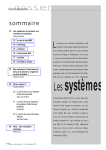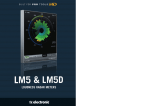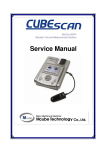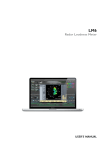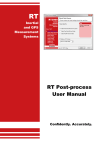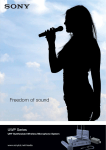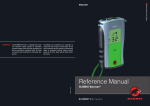Download Digital Beacon Pinpointing
Transcript
Digital Beacon Pinpointing In the Vertical Plane by Dave Barber1 A digital transceiver is defined for the purposes of this article as a beacon that uses two receiving antennas (orthogonal to one another) and a data processing algorithm to collect and interpret flux line data with sufficient confidence to enable the beacon to numerically estimate distance from the transmitting beacon and, much more importantly, to provide direction indication via a set of lights or arrows. This technique applies only to modern beacons with direction display, what you might call directional beacons2. These beacons excel in the secondary search, i.e., following the flux lines to the near field once a signal has been located. Upon reaching the near field, however, the digital technology has remained completely underutilized. This paper realizes the potential of directional beacon pinpointing by explaining the reasons and techniques for taking your beacon to the Vertical Plane. Digital’s great success in the secondary search has to do with dimensions and favorable orientation. The directional beacons, because they have two orthogonal receiving antennas, are a 2-dimensional (2-D) tool. They are keenly suited to reading flux lines in a 2-D space (i.e., a plane). In the secondary search, when you’re 30+ meters away, the flux field where you are is fairly spread out. It’s not an absolutely flat plane, but it’s close. And, you’re holding the beacon flat in front of you. The field is mostly horizontal, you’re holding your beacon horizontal, a 2-D tool properly oriented in a 2-D problem. Effortless. Just follow the beacon. The closer you get to the buried transceiver, however, the more you are moving into a region of up-down arching flux lines. Eventually you cross a threshold into a near-field zone where the flux field actually has more vertical movement than horizontal. You start seeing direction lights flash left and right, you see distance estimates spike. The beacon seems a little confused. What has happened? You moved. You were in a nice flat 2-D flux field with a nice flat 2-D beacon. You’ve moved into a very dynamic 3-D flux world, but . . . you still have a nice flat 2-D beacon. Your first handicap is you’re dimensionally outnumbered 3 to 2. Even worse, however, the near field hasn’t just added vertical . . . the near-field flux field is now MOSTLY vertical. There is really very little horizontal info in the near field. And where’s your beacon? Still flat in front of you, still horizontal? You’re completely missing MOST of the near field data. You’re dimensionally outnumbered and your orientation is completely wrong! That doesn’t sound good. But, no worries. This paper will show you how to solve both those problems with a simple roll of the wrist. 1 2 David B. Barber, Idaho Falls, ID, USA, [email protected] or [email protected] Modern dual-antenna digital transceivers capable of properly implementing this technique must have true direction indication (LEDs or arrows in a LCD; these arrows point in different directions) on the forward end of the beacon, and must have sufficiently precise near-field digital signal processing to detect slight changes in predominant flux field direction as required to exhibit the Jump Point signature behavior. The Jump Point behavior was first observed, and further explored ultimately producing this technique, while practicing with the Backcountry Access Tracker DTS™. In January 2003, both a new MAMMUT Barryvox™ and a new Ortovox X1™ were tested. The MAMMUT Barryvox™ was found to successfully locate Jump Points all the way down to the direction indication shutoff at 0.3 m (note: under personal configuration options, the direction indication disable was reset to 0.3 m from the default of 3.0 m). The Ortovox X1™ was found to successfully locate Jump Points in the digital-operative range between 10 m and the factory-set direction indication disable at 2.0 m. We’re going to reduce the large 3-D problem to a manageable 2-D problem (a single plane in space) and we’re going to show you how to orient your beacon in that 2-D plane for quick pinpointing. As the title indicates, and as this discussion has emphasized, most the action is vertical (up and down). So, our limited search space, our 2-D plane, is going to be vertical also. We’re going to find a very specific Vertical Plane and properly orient your beacon in it. The Vertical Plane The plane in which everything discussed in this article happens is the Vertical Plane. Each burial scenario has one Vertical Plane. The Vertical Plane, you will find, is a fairly thin slice of space (less than half a meter wide) that is full of easy-to-read-and-follow flux data. There are no nulls or spikes in the Vertical Plane. No beacon confusion in the Vertical Plane. The direction lights/arrows of your digi beacon are always pointing along the strongest flux line, the distance readings are always reasonably accurate. You will find you can completely trust your digital beacon in the Vertical Plane. Great, so where is the Vertical Plane? This very specific 2-dimensional slice of space is, of course, vertical, and it passes precisely through the axis of the transmitting antenna of the buried beacon. We don’t know where that is yet, but the digital beacon knows how to find it. We find the Vertical Plane by following the digital beacon to the pinpoint line. We Want the Vertical Plane, But First . . . the Pinpoint Line The pinpoint line is the one and only near-field straight line that is on the snow surface and that directly overlies the axial orientation of the transmitting antenna. It doesn’t really take any work on your part to find the pinpoint line. The beacon does it for you. But, there is a definite skill involved, a skill that can only be developed with practice. You have to learn to ignore that near-field beacon confusion to see the pinpoint line. Your beacon naturally puts you on the pinpoint line and at that same time it starts throwing you curve balls. You have to learn to ignore near-field misinformation and “realize the pinpoint line.” Easier said than done. The secondary search, as you well know, is the activity of following the beacon to the near field once you’ve picked up a signal. It starts 30+ meters from the buried transceiver with your beacon flat in your hands, horizontal to the world, and you follow its direction indication along a path of decreasing distance to the near field. Is the secondary search easy? You bet! The secondary search is child’s play with a digital beacon. But, seeing the pinpoint line at the end of the secondary search takes a cool head. The problem, of course, is that the horizontal-oriented digital beacon in your hand is flooded with vertical data. It will get confused. A direction flash off to one side, distance readings will spike, more direction flashes both sides. But in spite of that noise the beacon is mostly showing you a straight line. You must keep a cool head and see that straight line through the noise. Some secondary search approaches will straighten up aligned with the pinpoint line as much as 7-10 meters out. Other approaches will still be curving slightly at 3-4 meters. It all depends on where you first picked up a signal. But, regardless of how late your path straightens out, it will. And, regardless of the amount of flashing direction and display data, know you’re also getting enough good information to see the pinpoint line. Be cognizant of figuring out the pinpoint line throughout the secondary search and practice until you always come in right on the line. I cannot possibly overemphasize the importance of plenty of “pinpoint line realization practice.” Enough About the Pinpoint Line, Back to the Vertical Plane The next step after finding the pinpoint line on the snow, is to envision an imaginary wall that is straight up into the sky and down into the snow passing through the pinpoint line. This imaginary wall is the Vertical Plane (Figure 1). Note in Figure 1 how the one and only pinpoint line3 is on the snow surface overlying the axial orientation of the transmitting antenna (in this particular drawing it is a horizontal-oriented buried beacon). The transmitting antenna defines the pinpoint line. The pinpoint line defines the Vertical Plane. There is, clearly, only one plane, one sliver in space, that contains both the pinpoint line and the transmitting antenna. Only one Vertical Plane. Take a moment and really envision the plane. As stated previously, everything else we talk about in this article happens in the Vertical Plane. Note: if you haven’t already mastered pinpoint line realization, then it is time to stop reading. You must get outside for some serious “pinpoint line realization and Vertical Plane envisioning practice.” Please don’t go any further until you have mastered the pinpoint line. Figure 1: The Vertical Plane; it contains the transmitting antenna and the pinpoint line. 3 Modern digital beacons naturally lead the searcher into the near-field region on the one and only straight pinpoint line for almost all transmitting antenna orientations. There is, however, one very specific situation where resolving the pinpoint line can be less clear, this is with a truly vertical transmitting antenna. Only with the precisely straight up and down truly vertical antenna is there any potential for trouble in locating the pinpoint line. The problem with the vertical transmitter is not a lack of a pinpoint line, but rather an infinite number of equally valid pinpoint lines (because of the vertical axial orientation). Yes, in this particular case, the precisely vertical transmitting antenna, my statement “there is only one pinpoint line” is not correct. But no worries, with practice you will recognize this situation and know to automatically apply the techniques of this method which will be to go vertical and follow flux lines to a position directly over the buried beacon (what will be called the fountain scenario later in this writeup). Getting In the Vertical Plane4 Found the pinpoint line. Envisioned an imaginary wall through the pinpoint line. Now, think of the face of your beacon, the surface that contains the distance readout and the direction indication, as a framed picture that you want to hang on a wall. Then, hang the picture (your beacon’s face) on the imaginary wall (the Vertical Plane). Flat against the wall. By “hang the picture on the wall” we mean hold the beacon in the air, over the pinpoint line, in the Vertical Plane. Let’s call the end of the beacon face with the set of directional arrows the “top” of the picture. You can hang the picture upright (directional arrows point to the sky), you can hang the picture upside down (directional arrows point down at the pinpoint line on the snow), or you can hang the picture sideways. Through these rotations, however, the face of the beacon remains flat against the wall. You can slide the picture all over the imaginary wall, to the left or to the right (i.e., the entire length of the pinpoint line), down to the snow, as high as you can reach. All good, just keep the picture flat against the wall. Always flat against the wall. You are now in the Vertical Plane. You have limited your search space to a single plane that contains the transmitting antenna. You have placed your digital beacon in that very specific sliver of space. The 2-D tool has been perfectly positioned in a 2-D problem. You don’t realize it yet, but you’re already almost done. Digital Pinpointing Technique #1: Follow the Flux Lines of the Vertical Plane Sure, you’ve followed flux lines before. But, have you ever followed flux lines after having already limited your search space to a single plane that you knew already contained the transmitting antenna of the buried beacon? How do we follow the flux lines of the Vertical Plane? Simply follow the direction indication along a path of decreasing distance. In practice this means your beacon will nose dive down into the snow. Give it a try. Start with your beacon flat against the wall at chest height. What does the direction indication say? One of the arrows is lit up and the beacon is telling you “the strongest flux line at this exact spot on the imaginary wall is THIS WAY.” So, follow it. Repeat this from a few other starting points. All paths lead to the snow. Pull out your owner’s manual and take at look at the drawing of the flux line field. You must know the shape of this field if you’re going to pull off any flux line technique. You must appreciate that flux lines keep curving under the snow surface and you must account for that continuing curvature in picking your probe location. If you know the basic shape of the flux line field around the transmitting antenna and can maintain disciplined orientation of your beacon in the Vertical Plane, then you are already on top of this game. As you practice following flux lines in the Vertical Plane you will find you can “paint” the flux field of the imaginary wall in your mind just like you could paint a mural on a real wall. Trace a few flux lines and sweep your hands along those paths to implant the image. You’ll quickly become familiar with the possibilities. This pattern recognition is easy because these flux line 4 It should be noted that temporary vertical orientation or “tilt” of digital beacons has been mentioned in some guidance (see, for example, the 1998 Tracker DTS™ User Manual [TrackerManual98.pdf at http://www.bcaccess.com/techlibrary/trackermanuals.php]) and vertical orientations have long been a principle facet of advanced analog pinpointing techniques (see, for example, the discussion of analog bracketing in the MAMMUT Barryvox™ User Manual [user_manual_7_2002.pdf at http://www.barryvox.com/manuals/index_e.html] or Manuel Genswein’s paper Pinpointing In a Circle - An Effective and Reliable System for the Precise Location of Deep Burials [http://www.genswein.com/downloads.html]). This method differs from previous search guidance, however, in its adherence to a strictly defined Vertical Plane passing through the digital-found pinpoint line. murals really only come in two flavors. A vertical-oriented transmitting antenna sprays flux lines up and out like a fountain (Figure 2a). A horizontal transmitting antenna lies underneath a flux line rainbow (Figure 2b). Fountain or rainbow. Of course, there are ninety degrees worth of buried beacon transitions between these two extremes, but what are those really? They are nothing more than fountains tipping over turning into rainbows. Once you know these patterns, you will be able to know buried beacon orientation as well as location. Think about that! Figure 2a: The flux lines in the Vertical Plane of a vertical burial look like flux lines being sprayed up and out like a fountain. Following flux lines puts you right on top of the buried beacon. Figure 2b: The flux lines in the Vertical Plane of a horizontal burial look somewhat like the buried beacon is lying beneath a flux line rainbow. Note: Lots of continuing curvature in the remainder of the flux line path beneath surface to the buried beacon. Figures 2c-e show a few of the other flux line fields that you’ll run into in the Vertical Plane. Fountains, rainbows, or something recognizable between the two. Figure 2c Figure 2d Figure 2e You are now armed with a very powerful technique for pinpointing with your digital beacon. Your digi beacon leads you to the pinpoint line, you envision the Vertical Plane and you maintain disciplined orientation of your beacon in the Vertical Plane. You follow any number of flux lines to the snow surface and consider their common subsurface endpoint. You need, as with all flux line techniques, to be able to estimate continuing curvature5 (Unless you’re on top of a flux line fountain, right? Flux lines put you right on top of a vertical burial, Fig. 2a, and there is no more curvature if you’re right on top of it!). The probe point is on the pinpoint line overlying the subsurface intersection of the traced curving flux lines. 5 What exactly have we done here? We applied a technique to get your receiving beacon in a single thin plane with the transmitting antenna. In so doing you have a chance to follow “clean” flux lines. Want another easier practice technique to help you learn the curving shape of flux lines? Go to the park, place a transmitting beacon flat on a picnic table and explore the flux field around that picnic table while you keep your search beacon oriented horizontal at the height of that picnic table (i.e., transmitting antenna and your beacon are in the same plane). Digital Pinpointing Technique #2: The Jump Point Line The second technique being introduced in this article is built on an altogether new type of digital-possible data. For reasons that will soon be evident, this new data is being called the Jump Point. Holding the digital transceiver at chest height in the Vertical Plane, point the direction-indicating end straight down at the pinpoint line. In this second technique you will not be rotating the transceiver to follow its direction indication, but you will definitely be observing the directional lights. Begin walking the pinpoint line. We are sliding the upside-down picture along the imaginary wall at chest height. We are finding the chest-height Jump Point. The Jump Point is, specifically, the tangential meeting of the level path of the search beacon (a level chest-height path) with a curving flux line from the buried beacon. It is easy to find with a dual-antenna digital transceiver. For convenience, mentally label the direction-indicating lights or arrows on the search beacon in order as #1 through #5. As you approach the Jump Point, direction indication moves gradually but confidently to one side; specifically, the beacon’s direction indication is in the direction from which you are walking. Beacon itself is still pointed straight down. At the Jump Point, the direction indication suddenly jumps to the opposite side. It leaps from light #1 to light #5 without touching lights #2, #3, or #4 along the way. You can’t miss it! The Jump Point reveals the precision with which dualantenna digital signal processing observes the tangential skimming of the flux line. One moment the predominant flux line is down-trending to the right. But, within just a few centimeters, the flux line has peaked in height, rolled over and is down-trending to the left. Think about that. You are now at a tangential meeting with the curving flux line of the Vertical Plane that is cresting and rolling over at your chest height. Figure 3 depicts location of a chestheight Jump Point in the Vertical Plane. This is a good time to stop and see if I am telling the truth. Grab a couple beacons and see if you can find a chest-height Jump Point. Figure 3: Finding the chest-height Jump Point, i.e., the tangential meeting of the straight chest-height path of the digital search transceiver with the specific flux line of the Vertical Plane that is cresting and rolling over at chest height. Now that you know what the Jump Point is (i.e., tangential meeting with a flux line) and you know what it looks like (i.e., direction indication jumps to the opposite side), we introduce the Jump Point Line. You can easily locate several Jump Points in the Vertical Plane and over the pinpoint line at any height (e.g., at the level of your chest, waist, and knee). Jump Points do exist at all heights over the pinpoint line, they all look the same and they’re all equally easy to locate. As you find several Jump Points at different heights you will notice that these Jump Points seem to line up relative to one another. Locate as many Jump Points as you need to confirm this. In fact, those Jump Points do form a straight line headed down into the snow. And, now, the good news. This Jump Point Line is a straight path to the buried beacon (Figure 4). You now are armed with a second useful technique for pinpointing with your digital beacon. Your digi beacon leads you to the pinpoint line, you envision and enter the Vertical Plane. You locate Jump Points at several heights above the pinpoint line and project that Jump Point Line straight to the buried beacon. You can probe the Jump Point Line itself. Figure 4: Jump Points (red stars) form a straight line to the buried beacon. Thoughts on Preferred Techniques With a vertical transmitting antenna, the flux lines are flowing up and out like a fountain and your quickest location of the victim is to follow flux lines to a position directly over the buried beacon. For all other orientations following flux lines leads you to a position that is not directly over the victim and that requires some estimation of continuing curvature of flux lines. The more horizontal the buried beacon’s antenna (rainbow flux field), the more useful is the Jump Point Line. In fact, the Jump Point line is straight up and down over the horizontal buried beacon. There are ninety degrees of variation between the vertical burial (in which the flux lines place you directly over the buried beacon) and the horizontal burial (for which the Jump Point Line is directly over the buried beacon) but these situations all become obvious and easily recognized with a little practice. My personal recommendation is to learn to flow instantly from pinpoint line to Vertical Plane and immediately proceed with walking the pinpoint line with downward-pointing beacon looking for a chest-height Jump Point. Don’t slow down, don’t break stride, just keep going in one smooth instantaneous move as you walk the pinpoint line. In a fraction of a second you “realize the pinpoint line,” “envision the Vertical Plane,” roll your wrist to “put your beacon IN the Vertical Plane” in downward-oriented Jump Point-location posture and go get that chest-height Jump Point. Mentally mark that chest-height Jump Point on the imaginary wall. Then quickly check below it, to the left, to the right, for the waist-height Jump Point. Now a quick assessment: Are those two Jump Points close to one another or spread out, narrow or wide? If chest and waist Jump Points are within shoulder width (narrow), finish the Jump Point Line. If chest and waist Jump Points are wide, say twice shoulder width, trace a couple distance-decreasing flux lines. Between those two extremes? Consider a combination of both flux lines and a Jump Point Line. Figure 5 is a rotatable illustration of the Vertical Plane of three separate example burial scenarios. Each example scenario (blue, orange and green) has a snow surface/pinpoint line (the longest colored line) and Jump Points (red stars). Two of the scenarios have smaller colored arrows showing distance-decreasing flux line paths. Two of the scenarios have Jump Point Lines. Figure 5 is really three separate figures on one sheet. Twist the sheet to see the three different scenarios. Figure 5: Rotatable illustration of the Vertical Plane of three entirely separate example burial scenarios (blue, orange, and green). The longest colored line of each scenario is the pinpoint line (i.e., the snow surface). Small scenario-colored arrows indicate typical paths taken if following flux lines. Red stars are Jump Points found at different heights above the pinpoint line. Large arrows show Jump Point Lines. How would the BLUE nearly horizontal burial be best located? Jump Points are narrow, practically right under one another . . . so finish the Jump Point Line. The Jump Point Line is practically on top of the buried beacon and pointed straight at it. The ORANGE scenario is a nearly vertical burial. Jump Points are fairly wide. Skip the Jump Points and follow flux lines to the top of the flux line fountain. Notice I didn’t even draw in the Jump Point LineS (yes, there are two of them) on the vertical burial scenario. The GREEN burial scenario is a case where the Jump Points are about shoulder width. You know there’s some angle to the Jump Point Line but you should go ahead and finish it. See the Jump Point Line, see its angle, see where it enters the snow. But don’t probe just yet, let’s get a little more data. Quickly trace a couple distance-decreasing curving flux lines, say from chest and waist heights, down to the snow. See (in your mind’s eye) the flux lines’ continuing curvature under the snow. Now, remember your Jump Point Line, remember its straight-yet-angled path into the snow. Finally, project all those lines mentally and “see” their intersection under the snow. That’s the buried beacon. Let the width of that first pair of Jump Points be your guide. Narrow, finish the Jump Point Line. Wide, follow flux lines to the top of the flux line fountain. For all those cases in between, remember the straight Jump Point Line and several curving flux lines projections are always headed to the same subsurface intersection. The below surface intersection of these various lines is your very precise total Vertical Plane tool. Conclusion This article has introduced some new techniques for pinpointing with a directional beacon. This method requires that the searcher be armed with a direction-indicating multiple-antenna digital transceiver, that the searcher be able to recognize the near-field pinpoint line on the snow surface, that she/he be able to envision the Vertical Plane through the pinpoint line and, finally, that the searcher be disciplined in maintaining placement of the search beacon in the Vertical Plane. IN the Vertical Plane! Always flat against the imaginary wall. 2-D tool in a 2-D problem. These “pinpointing” or “fine search” techniques only begin as the secondary search ends by delivering you to the pinpoint line. Realizing the pinpoint line is the crux, the place where you make it or miss it. As the secondary search ends and you know you’re on the pinpoint line, flow into the Vertical Plane. Instantly roll your wrist to put your beacon in the Vertical Plane. No worries. Trust your beacon in the Vertical Plane. You can follow flux lines in the Vertical Plane. Following flux lines in the Vertical Plane will teach you exactly what flux fields really look like, fountains and rainbows. Practice. Study the flux field of the Vertical Plane in all burial orientations. This article also introduced Jump Points, the unique field signature viewable only on the direction display of the downward-pointing directional transceiver. Your first pair of chest- and waist-height Jump Points is your guide to the burial orientation. Are the Jump Points wide or narrow? Jump Points wide . . . follow flux lines to the top of the fountain. Jump Points narrow . . . finish the Jump Point Line. In between, use flux lines and Jump Point Line. This is absurdly easy stuff! Practice these techniques until your realization of the pinpoint line is instantaneous. Flow from pinpoint line to Vertical Plane to first pair of Jump Points in one fluid motion. Your wrist rolls the beacon into the Vertical Plane while your feet keep walking the pinpoint line. If you practice this you should be verification probing and digging within seconds of reaching the near field. Practice until it flows.












